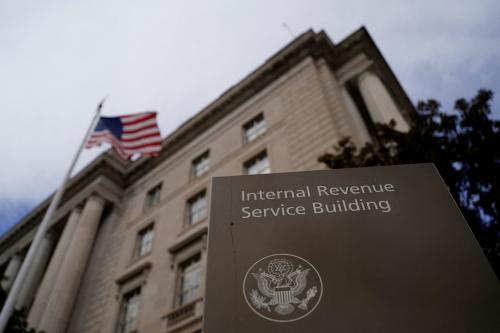The United States faces a long-term fiscal problem: Spending threatens to outrun revenues by such a large margin that the ratio of public debt to the size of gross domestic product (GDP) could increase inexorably. High debt will erode future generations’ living standards, hinder policymaking, and threaten national security. The good news is that the U.S. has successfully reduced debt several times in the past. The bad news is that previous fixes were too small to solve the current problem. Fixing the debt problem now requires far more substantial and sustainable policy changes than ever attempted.
Currently at 99%, the debt-to-GDP ratio is projected to rise persistently—without any changes to policy—to 166% in 2054. Maintaining the 99% ratio 30 years from now would require a combination of permanent tax increases and spending cuts equal to 2.65% of GDP (about $750 billion per year) if implemented in 2025, or larger if enacted begin later, according to recent work by Gale and Alan Auerbach. If Congress makes permanent the temporary provisions in the 2017 Tax Cuts and Jobs Act, the figures above rise to 229% and 4.3% (about $1.2 trillion), respectively. The nation’s fiscal challenges are enormous.
There’s not enough defense spending to cut
Fiscal problems have plagued the nation since its creation, at specific points in time. Following the Revolutionary War, debt-to-GDP rose to almost 30% in 1790 but fell back to below 6% by 1811. Similar fiscal cycles and debt-to-GDP ratios occurred after the Civil War and World War I: Debt skyrocketed during each war and fell dramatically afterward. In all three cases, cuts to defense spending led to stronger budgets and lower debt-to-GDP ratios.
Cuts in defense spending won’t solve today’s problem, though. Defense spending was only about 3% of GDP in 2023—already the lowest share since 2001—and down from 9.0% in 1960. The situations in the Ukraine, the Middle East, and elsewhere suggest the need to maintain and possibly increase such spending.
Economic growth won’t do the trick
Financing the costs of World War II drove the debt-GDP ratio to 106% in 1945, but the ratio fell gradually after that to less than 25% by 1974. Strong and sustained economic growth and, through much of the period, low interest rates can take the credit because it made GDP grow faster than pre-existing debt. And since the government ran slight surpluses on average, it did not accumulate new debt. (Defense spending fell, but higher entitlement spending later replaced it.)
Low interest rates and strong growth were ideal conditions for debt reduction then, but they are hard to replicate now. Interest rates have risen significantly in recent years. And the earlier period’s strong economic growth was fueled by baby boomers—including many women—joining the labor force. Now, though, boomers are retiring en masse, and women’s labor force participation has plateaued over the past couple of decades.
Consequently, real economic growth—which averaged 4.0% annually from 1950 to 1973, including 1.6% due to productivity and 2.3% due to labor force growth—is expected to be just 1.8% over the next 30 years, with about the same effect (1.4%) from productivity but a much smaller effect (only 0.4%) from labor force growth.
When the Social Security Trust Fund faced imminent exhaustion in 1983, a bipartisan commission proposed payroll tax increases and benefit cuts, which the president and Congress enacted. The key reform was gradually increasing the retirement age over time (a benefit cut not fully completed until 2022). The legislation also made some benefits taxable and accelerated scheduled increases in payroll tax rates.
Those changes were supposed to keep Social Security sound for 75 years. But only 40-odd years later, the gap in Social Security financing is about twice as large as in 1983. The problem has gotten worse in spite of a higher retirement age and higher payroll taxes.
Tax increases or spending cuts would need to be much, much larger
In 1993, Democratic President Bill Clinton and a Democratic Congress pushed through higher taxes and reduced spending growth. In combination with an economic boom and other policies, the changes helped reduce the debt-to-GDP ratio from 49.5% to 34.5% in seven years.
But the pure arithmetic of these changes suggests they were small—about 0.63% of GDP annually over the following four years, a small fraction of the fiscal gap going forward. Other factors substantially helped reduce the debt-to-GDP ratio in 1990s. Significantly larger tax increases or spending cuts will be needed going forward.
Reducing debt only seems impossible
Today’s fiscal outlook is unlike those experienced in our history. Neither a weak economy nor a war created the problem. Instead, an aging population, rising healthcare costs, and limited revenue growth fuel our fiscal woes amid rising inequality and political partisanship. In the absence of legislative action, problems will worsen.
Policymakers can tap some elements of previous debt-reduction efforts like thoughtful tax hikes and judicious reductions in spending growth. But the effort needs to be different this time around. The already high debt-to-GDP ratio requires much larger tax and spending changes. Our divisive political environment demands a bipartisan debt-reduction effort. New revenue sources may be needed—such as a value-added tax—to help close the yawning gap between revenues and outlays.
Can we do it? As Winston Churchill allegedly said, “You can always count on the Americans to do the right thing… after they have exhausted all of the other options.”
-
Acknowledgements and disclosures
The Brookings Institution is financed through the support of a diverse array of foundations, corporations, governments, individuals, as well as an endowment. A list of donors can be found in our annual reports published online here. The findings, interpretations, and conclusions in this report are solely those of its author(s) and are not influenced by any donation.
The Brookings Institution is committed to quality, independence, and impact.
We are supported by a diverse array of funders. In line with our values and policies, each Brookings publication represents the sole views of its author(s).





Commentary
Back to the future: Can the government reduce its debt again?
August 8, 2024